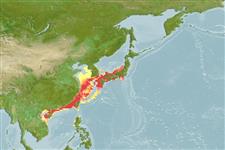>
Eupercaria/misc (Various families in series Eupercaria) >
Haemulidae (Grunts) > Plectorhinchinae
Etymology: Parapristipoma: Greek, para = the side of + Greek, pristis = saw + Greek, poma = operculum (Ref. 45335).
Environment: milieu / climate zone / depth range / distribution range
Ecologia
marinhas bentopelágico; oceanódromo. Subtropical; 39°N - 15°N, 105°E - 140°E
Indo-West Pacific: southern Japan, East China Sea and Taiwan.
Comprimento de primeira maturação / Tamanho / Peso / Idade
Maturity: Lm 18.0, range 16 - 20 cm
Max length : 40.0 cm SL macho/indeterminado; (Ref. 559); peso máx. publicado: 1.1 kg (Ref. 40637)
Cultured and released for fishery in Japan. The species prefers relative warm water, high salinity, and rocky shores. The species does seasonal offshore-inshore migrations in limited areas (Ref. 34104).
Oviparous, distinct pairing during breeding (Ref. 205). A couple ascends quickly to the surface and spawns (Ref. 34104).
Masuda, H., K. Amaoka, C. Araga, T. Uyeno and T. Yoshino, 1984. The fishes of the Japanese Archipelago. Vol. 1. Tokai University Press, Tokyo, Japan. 437 p. (text). (Ref. 559)
Status na Lista Vermelha da UICN (Ref. 130435)
Ameaça para os humanos
Harmless
Uso pelos humanos
Pescarias: espécies comerciais
Ferramentas
Relatórios especiais
Baixar XML
Fontes da internet
Estimates based on models
Preferred temperature (Ref.
123201): 18.2 - 26.6, mean 24.1 °C (based on 168 cells).
Índice de diversidade filogenética (Ref.
82804): PD
50 = 0.5625 [Uniqueness, from 0.5 = low to 2.0 = high].
Bayesian length-weight: a=0.00933 (0.00555 - 0.01568), b=3.01 (2.86 - 3.16), in cm total length, based on LWR estimates for this species & (Sub)family-body (Ref.
93245).
Nível Trófico (Ref.
69278): 3.4 ±0.45 se; based on food items.
Resiliência (Ref.
120179): médio(a), tempo mínimo de duplicação da população 1,4 - 4,4 anos (K=0.25-0.35; tm=2; Fec=30,083).
Fishing Vulnerability (Ref.
59153): Moderate vulnerability (36 of 100).
Nutrients (Ref.
124155): Calcium = 63.2 [13.8, 129.8] mg/100g; Iron = 0.987 [0.507, 1.843] mg/100g; Protein = 18.4 [16.5, 20.2] %; Omega3 = 0.33 [0.16, 0.59] g/100g; Selenium = 27.9 [14.4, 54.5] μg/100g; VitaminA = 28.1 [10.6, 75.8] μg/100g; Zinc = 0.795 [0.567, 1.126] mg/100g (wet weight);
